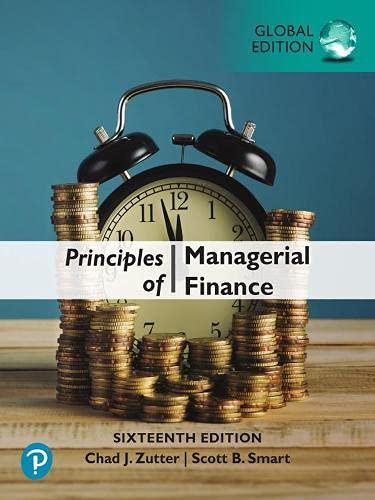
1) Recall that in a previous HW we showed that if the yield curve is restricted to move only in "parallel shifts", then arbitrage opportunities would be available. The purpose of this problem is to demonstrate that arbitrage-free models such as the Vasicek model eliminate these problems. Assume bonds are priced according to the Vasicek model. Hence, assume that if today is date- 0 and the current overnight 'spot rate' is r, then the price P(r,T) of a zero coupon bond with face value $T1 that matures at date- T is: P(r,T)=eA(T)rB(T), where the coefficients A(T) and B(T), which are functions only of time to maturity (T), are defined as: B(T)=(1eST)/SA(T)=(B(T)T)Y2B2(T)/4SY=L+(/S)(2/2S2) It is convenient to introduce the continuously-compounded yield to maturity y(r,T) via P(r,T)=ey(r,T)T. As such, we can write y(r,T)=(B(T)/T)r(A(T)/T). Note how this continuously compounded yield differs from what we usually use, where future values are discounted by: PV(0)=FV(T)/[1+y(T)]T. In contrast, here they are discounted by PV(0)=FV(T)ey(T)T. Related, note that an investment of $01 into a zero coupon bond with maturity-T buys a security with face value $T(1/P(r,T))=$T(ey(r,T)T). Below, assume that the parameters of the model are r=0.05,L=0.06,S=0.1,=0.1,=0.015 1A) Determine and plot i) the prices and ii) the YTM's for zero-coupon bonds with face value =$1, for maturities 1,2,,30 years. As in a previous HW, consider two portfolios: The first portfolio is currently worth $0100, and is a combination of two zero-coupon bonds. In particular, it has $050 invested in a zero coupon bond that matures one year from now, and it has $050 invested in a zero coupon bond that matures 19 years from now. 1B) Determine the Maturity Value = Face Value for each of these two zero-coupon bonds. 1) Recall that in a previous HW we showed that if the yield curve is restricted to move only in "parallel shifts", then arbitrage opportunities would be available. The purpose of this problem is to demonstrate that arbitrage-free models such as the Vasicek model eliminate these problems. Assume bonds are priced according to the Vasicek model. Hence, assume that if today is date- 0 and the current overnight 'spot rate' is r, then the price P(r,T) of a zero coupon bond with face value $T1 that matures at date- T is: P(r,T)=eA(T)rB(T), where the coefficients A(T) and B(T), which are functions only of time to maturity (T), are defined as: B(T)=(1eST)/SA(T)=(B(T)T)Y2B2(T)/4SY=L+(/S)(2/2S2) It is convenient to introduce the continuously-compounded yield to maturity y(r,T) via P(r,T)=ey(r,T)T. As such, we can write y(r,T)=(B(T)/T)r(A(T)/T). Note how this continuously compounded yield differs from what we usually use, where future values are discounted by: PV(0)=FV(T)/[1+y(T)]T. In contrast, here they are discounted by PV(0)=FV(T)ey(T)T. Related, note that an investment of $01 into a zero coupon bond with maturity-T buys a security with face value $T(1/P(r,T))=$T(ey(r,T)T). Below, assume that the parameters of the model are r=0.05,L=0.06,S=0.1,=0.1,=0.015 1A) Determine and plot i) the prices and ii) the YTM's for zero-coupon bonds with face value =$1, for maturities 1,2,,30 years. As in a previous HW, consider two portfolios: The first portfolio is currently worth $0100, and is a combination of two zero-coupon bonds. In particular, it has $050 invested in a zero coupon bond that matures one year from now, and it has $050 invested in a zero coupon bond that matures 19 years from now. 1B) Determine the Maturity Value = Face Value for each of these two zero-coupon bonds







